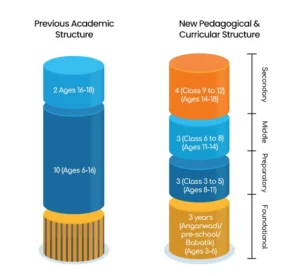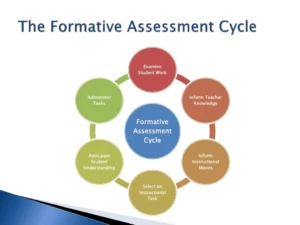India’s National Education Policy: A Transformative Vision for the Future
Introduction:
India’s education landscape is undergoing a significant transformation with the introduction of the National Education Policy (NEP) 2020 recommended by K. Kasturirangan Committee.
This landmark policy, approved by the Union Cabinet in July 2020, aims to revolutionize the country’s education system, ensuring inclusivity, quality, and relevance in learning from early childhood to higher education.
In this comprehensive guide, we’ll delve into the key highlights and implications of the NEP 2020, exploring its potential to shape the future of education in India.
When will the NEP be implemented?
The NEP started being implemented during the 2023-2024 academic year. It will be implemented by all states and UTs in India.
What changes will it bring?
The NEP brought various changes, including updates to the syllabus, modifications to the grade structure, and fundamental changes in the functioning of the Indian Educational System.
What does the NEP aim to achieve?
The NEP aims to create a Holistic Multidisciplinary Education with multiple entry/exit options that fosters creativity and rational thinking among learners.
Does NEP eliminate exams entirely, or does it redesign them?
While Grade 10 and 12 Board exams will continue, they will be redesigned to reduce the need for coaching classes. Students can choose subjects based on their interests, and exams will focus on core skills rather than memorization.
Exams will also be easier, allowing all students to pass with basic effort. Additionally, students can take exams twice a year for improvement if needed.
Now, let’s take a closer look at the National Education Policy. This comprehensive analysis will address all your questions and provide insights into the NEP.
Foundations of the NEP 2020:
Inclusive and Equitable Education:
The NEP’s focus on inclusive education aligns with Sustainable Development Goal 4, which aims to ensure inclusive and equitable quality education for all by 2030.
It aims to cater to the diverse needs of all learners, irrespective of socio-economic background or abilities.
The NEP emphasizes the importance of providing quality education to marginalized communities, such as girls and children with disabilities.
Quality and Relevance:
Emphasizes providing education aligned with the needs of the 21st century, fostering critical thinking and creativity.
The NEP advocates for the integration of vocational education and experiential learning to equip students with practical skills for the future workforce.
Key Features of the NEP 2020:
Presently, the 10+2 educational structure does not encompass children aged 3-6, as formal schooling typically begins at age 6 with Class 1. However, under the new 5+3+3+4 framework, Early Childhood Care and Education (ECCE) for children aged 3-6 is integrated, aiming to foster enhanced learning, development, and well-being from the earliest stages.

Early Childhood Care and Education (ECCE):
Over 85% of a child’s cumulative brain development occurs prior to the age of 6, indicating the critical importance of appropriate care and stimulation of the brain in the early years in order to ensure healthy brain development and growth.
NEP envisions universal access to high-quality ECCE for children aged 3 to 6 years.
According to UNICEF, investing in early childhood education yields significant returns, with every dollar spent resulting in a return of up to $17 in long-term benefits.
Foundational Literacy and Numeracy:
The ability to read and write, and perform basic operations with numbers, is a necessary foundation and an indispensable prerequisite for all future schooling and lifelong learning.
There will be an increased focus on foundational literacy and numeracy – and generally, on reading, writing, speaking, counting, arithmetic, and mathematical thinking – throughout the preparatory and middle school curriculum.
According to UNESCO, India has the largest school-age population in the world, highlighting the importance of robust educational reforms.
School Education:
NEP advocates for holistic development, multidisciplinary learning, and integration of vocational education from Grade 6.
Higher Education:
Proposes reforms including a single regulatory body for HEIs, flexible curricula, and emphasis on research and innovation.
Three language formula and Multilingual learning process
Research indicates that children learn languages rapidly between the ages of 2 and 8, and being able to speak multiple languages has many cognitive benefits for young students.
The three-language plan will still be used. If students want to switch one or more of the three languages they are learning, they can do this in Grade 6 or 7. They just need to show they can speak three languages at a basic level.
Nurturing Skills:
To ensure students learn important skills, NEP blends different subjects together in the curriculum.
This includes adding modern topics like Artificial Intelligence, Design Thinking, and vocational skills. Digital skills like coding and understanding computers. Environmental Education will also be included.
Assessment and Evaluation:

Competency-Based Assessment:
Shifting from rote memorization to competency-based assessment to measure holistic learning outcomes. NEP proposes transition from Annual Report Card to Holistic Progress Card
Formative Assessment Practices:
Encouraging formative assessment practices to provide timely feedback and support student learning.
Peer assessment, self-assessment, and feedback-oriented assessments can empower students to take ownership of their learning and improve their performance.
Encouraging Students’ Unique Talent:
Every student has unique talents that need to be discovered and nurtured. If a student shows exceptional abilities in a certain area, must be encouraged to explore it further.
Teachers will provide extra materials and encouragement in subjects the students are passionate about. This could include activities like Science or Math Circles, Music and Dance performances, Chess, Poetry, Languages, Drama, Debates, Sports, or Eco and Yoga clubs.
Teacher-Pupil Ratio:
Current Teacher-Pupil Ratio:
According to UNESCO, the teacher-pupil ratio in India is approximately 1:32, highlighting the need for additional teaching staff.
Ideal Teacher-Pupil Ratio:
The NEP aims to reduce the teacher-pupil ratio to 1:25 in schools to ensure personalized attention and effective learning outcomes.
Teacher Empowerment:
Providing continuous professional development opportunities for teachers to enhance their skills and pedagogical practices.
Programs like the National Initiative for School Heads’ and Teachers’ Holistic Advancement (NISHTHA) aim to train teachers in pedagogical techniques and innovative teaching methods.
School Structure and Fluid Entry Scheme:
Fluid School Entry Scheme:
The NEP proposes a flexible school entry and exit plan, allowing students to enter and exit at different stages based on their interests and aptitudes.
Multidisciplinary Education:
Schools will offer multidisciplinary education, allowing students to choose subjects across arts, sciences, vocational courses, and sports.
NEP’s Focus on Dropout Prevention:
One of the primary goals of the schooling system must be to ensure that children are enrolled in
and are attending school.
The GER-Gross Enrollment Ratio-for Grades 6-8 was 90.9%, while for Grades 9-10 and 11-12 it was only 79.3% and 56.5%, respectively – indicating that a significant proportion of enrolled students drop out after Grade 5 and especially after Grade 8.
It will be a top priority to bring these children back into the educational fold as early as possible, and to prevent further students from dropping out, with a goal to achieve 100% Gross Enrolment Ratio in preschool to secondary level by 2030.
Overall Literacy Rate:
India’s Literacy Rate:
According to the Census of India 2011, India’s overall literacy rate stands at 74.04%, reflecting significant progress in recent decades.
NEP’s Impact on Literacy:
The NEP aims to achieve 100% youth and adult literacy through innovative teaching methods, inclusive education practices, and targeted interventions for marginalized communities.
Role of Technology:

Digital Infrastructure:
Building robust digital infrastructure to support online learning and access to educational resources.
Example: The SWAYAM platform, launched by the Government of India, offers free online courses from various institutions, providing access to quality education to learners across the country.
A national repository of high-quality resources on foundational literacy and numeracy will be
made available on the Digital Infrastructure for Knowledge Sharing (DIKSHA).
Kasturirangan Committee and Its Recommendations:
Kasturirangan Committee:
The NEP was influenced by the recommendations of the Kasturirangan Committee, which proposed comprehensive reforms to address challenges in the education sector.
Recommendations Implemented:
Several recommendations of the Kasturirangan Committee, such as the restructuring of school education and emphasis on vocational training, have been incorporated into the NEP.
How is NEP 2020 different from previous policies?
Previous education policies mainly focused on ensuring everyone has access to education. The new policy addresses the goals that were not fully achieved in the National Policy on Education of 1986, which was updated in 1992.
A significant change since then is the Right of Children to Free and Compulsory Education Act 2009, which made it a legal requirement for all children to receive elementary education.
Conclusion:
The National Education Policy 2020 heralds a new era of educational reform in India, setting the stage for a holistic, inclusive, and future-ready education system. While challenges persist, the NEP offers hope for realizing the transformative potential of education and building a brighter future for India’s learners.
With concerted efforts from policymakers, educators, and communities, India can leverage the NEP to create an education system that nurtures talent, fosters innovation, and empowers future generations.
